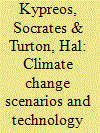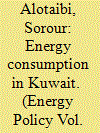|
|
|
Sort Order |
|
|
|
Items / Page
|
|
|
|
|
|
|
| Srl | Item |
| 1 |
ID:
103611


|
|
|
|
|
| Publication |
2011.
|
| Summary/Abstract |
This paper evaluates the productivity of municipal solid waste incinerators (MSWIs) by addressing the following questions: (1) to what extent should one further increase the production of power generation while maintaining the emission of noxious air at the current level?; (2) To what extent should one further decrease the emission of noxious air while maintaining the production of power generation at the current level?; and (3) To what extent should one increase the production of power generation and decrease the emission of noxious air simultaneously? To effectively address these questions to improve performance, the power generation and pollution control efficiencies are evaluated using TODEA (two-objective data envelopment analysis), as well as the overall efficiency evaluated using Tone's NS-overall model (slacks-based measure with non-separable desirable and undesirable outputs for evaluating overall efficiency). A MSWI case study in Taiwan with the panel data covering the period of 2004-2008 reveals that the power generation and overall efficiencies of build-operate-transfer are more efficient, on average, than those of public-own-operate and build-own-operate. However, the three building and operation types do not significantly differ in pollution control efficiency.
|
|
|
|
|
|
|
|
|
|
|
|
|
|
|
|
| 2 |
ID:
110573


|
|
|
|
|
| Publication |
2011.
|
| Summary/Abstract |
With a focus on the residential sector, this paper explores the likelihood of the UK government meeting its energy targets. The paper contends that energy policy needs to take into account the interplay of four major factors: an ageing population of increasing diversity; a cultural inclination for older housing much of which is thermally inefficient; levels of fuel poverty; and the inexorable rise of consumer spending on leisure related services and goods. Decisions made by older households (both the poorer and the better off) may be critical to the success of energy policy. Among the better off the changing expectations of the baby boomers, with their predilection for consumption and travel, may have particular impact. The paper concludes that much of the reduction in carbon footprint made by older people's choices in heating and insulation may be offset, not only by increasing domestic thermal comfort, but also potentially by increasing consumables in the home and other consumer lifestyle choices. What could be achieved at best, may be a shift in energy mix.
|
|
|
|
|
|
|
|
|
|
|
|
|
|
|
|
| 3 |
ID:
110579


|
|
|
|
|
| Publication |
2011.
|
| Summary/Abstract |
We apply a specific version of MERGE-ETL, an integrated assessment model, to study global climate policies supported by Technology Transfer Protocols (TTPs). We model a specific formulation of such a TTP where donor countries finance via carbon tax revenues, the diffusion of carbon-free technologies in developing countries (DCs) and quantify its benefits. Industrialized countries profit from increased technology exports, global diffusion of advanced technology (leading to additional technology learning and cost reductions) and reduced climate damages through the likelihood of greater global participation in a new international agreement. DCs experience increased welfare from access to subsidized technology, and profit from the reduction of damages related to climate change and expected secondary benefits of carbon abatement (such as reduced local and regional air pollution). The analysis identifies potential candidate technologies that could be supported under a TTP, and the impact of a TTP on economic development (including the flow of transfer subsidies) and global emissions. Although a TTP may encourage additional participation, such a proposal is only likely to be successful if an increased willingness to pay to avoid climate damages is accepted, first by the present and future generations of the industrialized world and later on, when sufficient economic growth is accumulated, by today's developing countries.
|
|
|
|
|
|
|
|
|
|
|
|
|
|
|
|
| 4 |
ID:
103612


|
|
|
|
|
| Publication |
2011.
|
| Summary/Abstract |
In a quest for strategic and environmental benefits, the developed countries have been trying for many years to increase the share of alternative fuels in their transportation fuel mixes. They have met very little success though. In this paper, we examine the experience of Argentina with compressed natural gas. We conducted interviews with a wide range of stakeholders and analyzed econometrically data collected in Argentina to investigate the factors, economic, political, and others that determined the high rate of adoption of this fuel. A central objective of this research was to identify lessons that could be useful to developed countries in their efforts to deploy alternative fuel vehicles. We find that fuel price regulation was a significant determinant of the adoption of compressed natural gas, while, contrary to expectations, government financing of refueling infrastructure was minimal.
|
|
|
|
|
|
|
|
|
|
|
|
|
|
|
|
| 5 |
ID:
103595


|
|
|
|
|
| Publication |
2011.
|
| Summary/Abstract |
Offshore wind resources appear abundant, but technological, economic and planning issues significantly reduce the theoretical potential. While massive investments are anticipated and planners and developers are scouting for viable locations and consider risk and impact, few studies simultaneously address potentials and costs together with the consequences of proposed planning in an analytical and continuous manner and for larger areas at once. Consequences may be investments short of efficiency and equity, and failed planning routines. A spatial resource economic model for the Danish offshore waters is presented, used to analyse area constraints, technological risks, priorities for development and opportunity costs of maintaining competing area uses. The SCREAM-offshore wind model (Spatially Continuous Resource Economic Analysis Model) uses raster-based geographical information systems (GIS) and considers numerous geographical factors, technology and cost data as well as planning information. Novel elements are weighted visibility analysis and geographically recorded shipping movements as variable constraints. A number of scenarios have been described, which include restrictions of using offshore areas, as well as alternative uses such as conservation and tourism. The results comprise maps, tables and cost-supply curves for further resource economic assessment and policy analysis. A discussion of parameter variations exposes uncertainties of technology development, environmental protection as well as competing area uses and illustrates how such models might assist in ameliorating public planning, while procuring decision bases for the political process. The method can be adapted to different research questions, and is largely applicable in other parts of the world.
|
|
|
|
|
|
|
|
|
|
|
|
|
|
|
|
| 6 |
ID:
103605


|
|
|
|
|
| Publication |
2011.
|
| Summary/Abstract |
The possible uses of biomass for energy provision are manifold. Gaseous, liquid and solid bioenergy carriers can be alternatively converted into heat, power or transport fuel. The contribution of the different utilisation pathways to environmental political targets for greenhouse gas (GHG) emission reduction and energy political targets for the future share of renewable energy vary accordingly to their techno-economic characteristics. The aim of the presented study is to assess the different biomass options against the background of energy and environmental political targets based on a system analytical approach for the future German energy sector. The results show that heat generation and to a lower extent combined heat and power (CHP) production from solid biomass like wood and straw are the most cost effective ways to contribute to the emission reduction targets. The use of energy crops in fermentation biogas plants (maize) and for production of 1st generation transportation fuels, like biodiesel from rapeseed and ethanol from grain or sugar beet, are less favourable. Optimisation potentials lie in a switch to the production of 2nd generation biofuels and the enhanced use of either biomass residues or low production intensive energy crops.
|
|
|
|
|
|
|
|
|
|
|
|
|
|
|
|
| 7 |
ID:
110576


|
|
|
|
|
| Publication |
2011.
|
| Summary/Abstract |
Many scenarios have been generated in the last years analysing the international energy market. The variety of these scenarios is manifold, as they are generated by different institutions using different methodological approaches and different framework assumptions. However, these scenarios can roughly be classified into three main groups: "moderate", "climate protection" and "resource scarcity and high fossil fuel prices". Analysing the German energy market makes a fourth scenario group necessary, which considers the possible revision of the decided nuclear energy phase out. Most of the existing scenarios developed by different institutions can be allocated into one of these groups. A representative scenario for each group has been selected to illustrate the development of the energy sector until 2030. Contrary to the worldwide primary energy demand (PED), the German PED decreases in each scenario, even though the drop differs strongly throughout the scenarios. On the other hand the structure of the PED in 2030 varies strongly for each scenario, especially regarding the share of fossil energy sources. However, a common robust result can be observed throughout all scenarios, namely the high increase in the share of the renewable energy resources, although the scenario generation processes are not always robust.
|
|
|
|
|
|
|
|
|
|
|
|
|
|
|
|
| 8 |
ID:
103629


|
|
|
|
|
| Publication |
2011.
|
| Summary/Abstract |
This study investigates the impacts of high international oil prices on the bioethanol and corn markets in the US. Between 2007 and 2008, the prices of major grain crops had increased sharply, reflecting the rise in international oil prices. These dual price shocks had caused substantial harm to the global economy. Employing a structural vector auto-regression model (SVAR), we analyze how increases in international oil prices could impact the prices of and demand for corn, which is used as a major bioethanol feedstock in the US. The results indicate that an increase in the oil price would increase bioethanol demand for corn and corn prices in the short run and that corn prices would stabilize in the long run as corn exports and feedstock demand for corn decline. Consequently, policies supporting biofuels should encourage the use of bioethanol co-products for feed and the development of marginal land to mitigate increases in the feedstock price.
|
|
|
|
|
|
|
|
|
|
|
|
|
|
|
|
| 9 |
ID:
110570


|
|
|
|
|
| Publication |
2011.
|
| Summary/Abstract |
This study investigates the impacts of high international oil prices on the bioethanol and corn markets in the US. Between 2007 and 2008, the prices of major grain crops had increased sharply, reflecting the rise in international oil prices. These dual price shocks had caused substantial harm to the global economy. Employing a structural vector auto-regression model (SVAR), we analyze how increases in international oil prices could impact the prices of and demand for corn, which is used as a major bioethanol feedstock in the US. The results indicate that an increase in the oil price would increase bioethanol demand for corn and corn prices in the short run and that corn prices would stabilize in the long run as corn exports and feedstock demand for corn decline. Consequently, policies supporting biofuels should encourage the use of bioethanol co-products for feed and the development of marginal land to mitigate increases in the feedstock price.
|
|
|
|
|
|
|
|
|
|
|
|
|
|
|
|
| 10 |
ID:
103607


|
|
|
|
|
| Publication |
2011.
|
| Summary/Abstract |
In Kuwait, the consumption of oil, the country's main source of energy, is increasing year by year. In addition to the harsh climate and the rapid economic and construction growth in the country, there are further aspects of energy inefficiency. While 10% of the produced energy was being consumed locally in 1980, this percentage increased to 20% in 2005 and is expected to reach 40% by 2015. If this situation continues, the country will be forced to increase production or reduce exportation. Both options will cause serious problems to the country in meeting future energy demands due to its dependence on oil as a source of income, shortages of other energy resources, and the environmental care of the country.
In this work, we assess the energy situation in Kuwait and its historical, current, and future conditions with a focus on the power plant sector, as it is the major consumer of energy in the country.
Finally, an attempt is made to briefly describe the most realistic and efficient electricity production solutions available and to discuss other alternative resources such as nuclear, solar, and wind energy.
|
|
|
|
|
|
|
|
|
|
|
|
|
|
|
|
| 11 |
ID:
103600


|
|
|
|
|
| Publication |
2011.
|
| Summary/Abstract |
This paper applies the panel unit root, heterogeneous panel cointegration and panel-based dynamic OLS to re-investigate the co-movement and relationship between energy consumption and economic growth for 30 provinces in mainland China from 1985 to 2007. The empirical results show that there is a positive long-run cointegrated relationship between real GDP per capita and energy consumption variables. Furthermore, we investigate two cross-regional groups, namely the east China and west China groups, and get more important results and implications. In the long-term, a 1% increase in real GDP per capita increases the consumption of energy by approximately 0.48-0.50% and accordingly increases the carbon dioxide emissions by about 0.41-0.43% in China. The economic growth in east China is energy-dependent to a great extent, and the income elasticity of energy consumption in east China is over 2 times that of the west China. At present, China is subject to tremendous pressures for mitigating climate change issues. It is possible that the GDP per capita elasticity of carbon dioxide emissions would be controlled in a range from 0.2 to 0.3 by the great effort.
|
|
|
|
|
|
|
|
|
|
|
|
|
|
|
|
| 12 |
ID:
110669


|
|
|
|
|
| Publication |
2011.
|
| Summary/Abstract |
Energy poverty is a well-established concept among energy and development specialists. International development organizations frequently cite energy-poverty alleviation as a necessary condition to reduce income poverty. Several approaches used to measure energy poverty over the past 20 years have defined the energy poverty line as the minimum quantity of physical energy needed to perform such basic tasks as cooking and lighting. This paper uses a demand-based approach to define the energy poverty line as the threshold point at which energy consumption begins to rise with increases in household income. At or below this threshold point, households consume a bare minimum level of energy and should be considered energy poor. This approach was applied using cross-sectional data from a comprehensive 2004 household survey representative of rural Bangladesh. The findings suggest that some 58 percent of rural households in Bangladesh are energy poor, versus 45 percent that are income poor. The findings also suggest that policies to support rural electrification and greater use of improved biomass stoves might play a significant role in reducing energy poverty.
|
|
|
|
|
|
|
|
|
|
|
|
|
|
|
|
| 13 |
ID:
110582


|
|
|
|
|
| Publication |
2011.
|
| Summary/Abstract |
Global warming, climate change and the recent global financial crisis have emphasised the need for reducing carbon emissions whilst also ensuring economic feasibility. This study addresses this topic by investigating the technical and economic feasibility of replacing diesel power generation with hybrid wind power systems in remote communities. For this purpose, the economic, technical and environmental characteristics of eight different hybrid wind power systems were established and compared in respect to their performance in the isolated community of French Island (Victoria, Australia). The results obtained in this study demonstrated the economic and environmental superiority of the hybrid wind-diesel-battery system over all other systems studied in this project. This system was found to have the lowest net present cost and cost per kWh among the modelled systems. Furthermore, the results clearly indicated that hybrid wind power systems are, in general, a feasible and preferable alternative to diesel power generation on the French Island. The research methodology and procedure that were developed in this project can be used to investigate and identify the most viable hybrid power system for other remote communities based on their specific environmental, social and economic circumstances.
|
|
|
|
|
|
|
|
|
|
|
|
|
|
|
|
| 14 |
ID:
110577


|
|
|
|
|
| Publication |
2011.
|
| Summary/Abstract |
In this paper we apply Stochastic Frontier Analysis through a distance function to investigate the impact of firm size on productivity development in electricity distribution. We use a sample of seventeen Brazilian firms from 1998 to 2005 and decompose productivity into technical efficiency, scale efficiency and technical change. Moreover, a further step is to decompose the technical change measurement into several components. The results indicate that firm size is important for industry's productivity, and therefore a key aspect to consider when making decisions that affect the market structure in the electricity distribution industry.
|
|
|
|
|
|
|
|
|
|
|
|
|
|
|
|
| 15 |
ID:
110581


|
|
|
|
|
| Publication |
2011,
|
| Summary/Abstract |
This paper analyzes the value and cost of line-pack flexibility in liberalized gas markets through examination of the techno-economic characteristics of gas transport pipelines and the trade-offs between different ways to use the infrastructure: transport and flexibility. Line-pack flexibility is becoming increasingly important as a tool to balance gas supply and demand over different periods. In the European liberalized market context, a monopolist unbundled network operator offers regulated transport services and flexibility (balancing) services according to the network code and balancing rules. Therefore, gas policy makers should understand the role and consequences of line-pack regulation. The analysis shows that the line-pack flexibility service has an important economic value for the shippers and the TSO. Furthermore, the analysis identifies distorting effects in the gas market due to inadequate regulation of line-pack flexibility: by disregarding the sunk costs of flexibility in the balancing rules, the overall efficiency of the gas system is decreased. Finally, the analysis demonstrates that the actual costs of line-pack flexibility are related to the peak cumulative imbalance throughout the balancing period. Any price for pipeline flexibility should, therefore, be based on the related trade-off between the right to use the line-pack flexibility and the provision of transport services
|
|
|
|
|
|
|
|
|
|
|
|
|
|
|
|
| 16 |
ID:
103623


|
|
|
|
|
| Publication |
2011.
|
| Summary/Abstract |
This paper evaluates whether the U.S. electricity sector is directed away from carbon-intensive technological lock-in, and which factors are contributing, or have potential to contribute, to a possible reorientation of the industry. With the application of a historical analysis of the electricity sector from the late nineteenth century through current day, this analysis finds that, although the industry still relies primarily on carbon-intensive fossil fuel operations, several recent trends indicate that the industry is becoming less carbon intensive, smaller in generation system scale, and more sustainable in operations. Crucial drivers-firm level interactions with technological change, industry leadership and market structure, government intervention and policy momentum, and citizen involvement and behavior patterns-that have traditionally shaped the structure, scale, and environmental footprint of the industry, have also played a prominent role in recent transformations. These results indicate that triggering or extraordinary events may not be necessary to initiate an escape from carbon lock-in in the electricity sector. Complete escape is not yet definitive, however, and it remains to be seen whether the industry is able to transform entirely before any significant climate change disturbances occur.
|
|
|
|
|
|
|
|
|
|
|
|
|
|
|
|
| 17 |
ID:
103603


|
|
|
|
|
| Publication |
2011.
|
| Summary/Abstract |
The impact of oil price shocks on the macroeconomy has received a great deal of attention since the 1970 s. Initially, many empirical studies found a significant negative effect between oil price shocks and GDP but more recently, empirical studies have reported an insignificant relationship between oil shocks and the macroeconomy. A key feature of existing research is that it applies predominantly to advanced, oil-importing countries. For oil-exporting countries, different conclusions are expected but this can only be ascertained empirically. This study conducts an empirical analysis of the effects of oil price shocks on a developing country oil-exporter-Nigeria. Our findings showed that oil price shocks do not have a major impact on most macroeconomic variables in Nigeria. The results of the Granger-causality tests, impulse response functions, and variance decomposition analysis all showed that different measures of linear and positive oil shocks have not caused output, government expenditure, inflation, and the real exchange rate. The tests support the existence of asymmetric effects of oil price shocks because we find that negative oil shocks significantly cause output and the real exchange rate.
|
|
|
|
|
|
|
|
|
|
|
|
|
|
|
|
| 18 |
ID:
110571


|
|
|
|
|
| Publication |
2011.
|
| Summary/Abstract |
China is the largest solar photovoltaic cell producer in the world, with more than one third of worldwide production in 2008, exporting more than 95 percent of what it produces. The purpose of this paper is to understand the drivers of this success and its limits, with a particular emphasis on the role of technology transfers and innovation. Our analysis combines a review of international patent data at a detailed technology level with field interviews of ten Chinese PV companies. We show that Chinese producers have acquired the technologies and skills necessary to produce PV products through two main channels: the purchasing of manufacturing equipment in a competitive international market and the recruitment of skilled executives from the Chinese diaspora who built pioneer PV firms. The success of these firms in their market is, however, not reflected in their performance in terms of innovation. Rather, patent data highlight a policy-driven effort to catch up in critical technological areas
|
|
|
|
|
|
|
|
|
|
|
|
|
|
|
|
| 19 |
ID:
103598


|
|
|
|
|
| Publication |
2011.
|
| Summary/Abstract |
This study presents fossil-fuel related CO2 emissions in Austria and Czechoslovakia (current Czech Republic and Slovakia) for 1830-2000. The drivers of CO2 emissions are discussed by investigating the variables of the standard Kaya identity for 1920-2000 and conducting a comparative Index Decomposition Analysis. Proxy data on industrial production and household consumption are analysed to understand the role of the economic structure. CO2 emissions increased in both countries in the long run. Czechoslovakia was a stronger emitter of CO2 throughout the time period, but per-capita emissions significantly differed only after World War I, when Czechoslovakia and Austria became independent. The difference in CO2 emissions increased until the mid-1980s (the period of communism in Czechoslovakia), explained by the energy intensity and the composition effects, and higher industrial production in Czechoslovakia. Counterbalancing factors were the income effect and household consumption. After the Velvet revolution in 1990, Czechoslovak CO2 emissions decreased, and the energy composition effect (and industrial production) lost importance. Despite their different political and economic development, Austria and Czechoslovakia reached similar levels of per-capita CO2 emissions in the late 20th century. Neither Austrian "eco-efficiency" nor Czechoslovak restructuring have been effective in reducing CO2 emissions to a sustainable level.
|
|
|
|
|
|
|
|
|
|
|
|
|
|
|
|
| 20 |
ID:
103625


|
|
|
|
|
| Publication |
2011.
|
| Summary/Abstract |
Fuel poverty, or inability to afford adequate heating for a reasonable outlay of expenditure, is a significant and under-researched problem in New Zealand. The connection between fuel poverty, and electricity disconnection or 'self-disconnection' is analysed for four cities using prepayment metering to pay for electricity. A price comparison analysis on a government-sponsored website showed that prepayment metering was more expensive than other payment options. This website analysis was supplemented by qualitative data from older people with chronic respiratory disease expressing their views about electricity disconnection and prepayment metering. We show that prepayment metering for electricity is more expensive than other payment methods in New Zealand and that older people's insights provide valuable context to these issues. Under the present payment schedule, the use of prepayment metering to pay for electricity is not a suitable policy instrument to address fuel poverty, which remains problematic. The deregulated electricity market continues to lead to increases in the real price of residential electricity and in the number of people in fuel poverty. We offer policy suggestions for reducing fuel poverty in New Zealand.
|
|
|
|
|
|
|
|
|
|
|
|
|
|
|
|
|
|
|
|
|